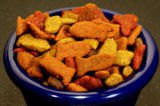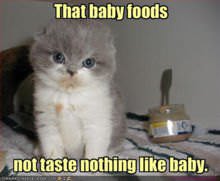While dry cat food is cheaper and more convenient (can be stored easily and makes litter boxes easier to clean), wet (canned) food is generally believed to better meet the nutritional needs of a pet cat because it is closer to raw food and provides better hydration. The smell of canned cat food can be quite off-putting; however, it is better for the cat's health. While some experts recommend eliminating dry food from a cat's diet, it is often more practical for pet owners to maintain a balance of both dry and wet food in their cat's diet.
Comparison chart
Nutrition
Dry cat food can contain a lot of filler, including more carbohydrates than a cat would eat in the wild.[1] For example, Friskies Indoor Delights dry food is 30% protein, 9% fat, 5% fiber, 42% carbohydrates and 12% moisture.
Wet cat food is mostly made up of meat or fish, which is closer to a cat’s natural diet.[2] Friskies Classic Pate wet cat food is 10% protein, 5% fat, 8.63% carbohydrates, 1% fiber, 78% moisture, 3.5% ash and 0.05% taurine.
Hydration
Dry food averages about 10% water. As a cat’s natural prey is about 70% water, cats fed dry food usually don’t get enough water. This can lead to chronic dehydration and health problems like renal failure and urinary crystals.[3]
Cost
Wet or canned cat food is generally more expensive than dry food. For example, while 6.3 lbs of Friskies Indoor Delight dry food is $7.18 from Walmart and typically lasts a month, 12 5.5 oz meals of Friskies pate canned cat food costs $5.48 from the same store. So wet cat food would cost at least twice as much as dry cat food.
Convenience
Dry cat food can be left constantly in the cat’s bowl, so that the cat can eat whenever it is hungry. It does not spoil when opened.
Wet cat food is messier and smellier, and it has a shorter shelf life once it has been opened. It cannot be left in the bowl for more than a couple of hours.
Health Issues
Cats that eat only dry food are slightly more likely to become obese that cats that eat wet food, due to the high carbohydrate levels. Cats that eat only dry food are also slightly more likely to develop diabetes.[4]
Wet cat food might lead to dental problems including gingivitis.[5]
Harmful Foods for Cats
There are certain foods that are very harmful for cats and must be avoided. The full list is available here and some examples are presented below:
- Cats can get addicted to tuna so while occasional feeding of tuna is okay, they must not be fed a steady diet of tuna.
- Onions in all forms should also be avoided because they can cause anemia. Chives and garlic can cause gastrointestinal problems for cats.
- While kittens can tolerate milk, bodies of most adult cats cannot process dairy products.
- Alcohol can be very dangerous for cats and must be avoided.
- Some cats get seriously ill after eating grapes or raisins.
- Coffee, candy, gum and chocolate are also harmful -- sometimes even lethal -- for cats.
References
- http://www.catster.com/cat-food/cat-food-wet-or-dry
- http://www.consumersearch.com/cat-food/dry-vs-canned-cat-food
- http://freecatadvice.com/wet-vs-dry-cat-fod/
- http://pets.webmd.com/cats/guide/feeding-your-adult-cat-what-you-need-to-know
- http://www.friskies.com/Cat-Food/Wet-Cat-Food/Classic-Pate-Chicken-Tuna-Dinner
- http://parenting-furkids.com/index.php?topic=747.0





 Cat
Cat  Kibble
Kibble  Fur
Fur  Bed Bugs
Bed Bugs  Golden Retriever
Golden Retriever  Dog
Dog
Comments: Dry Cat Food vs Wet Cat Food